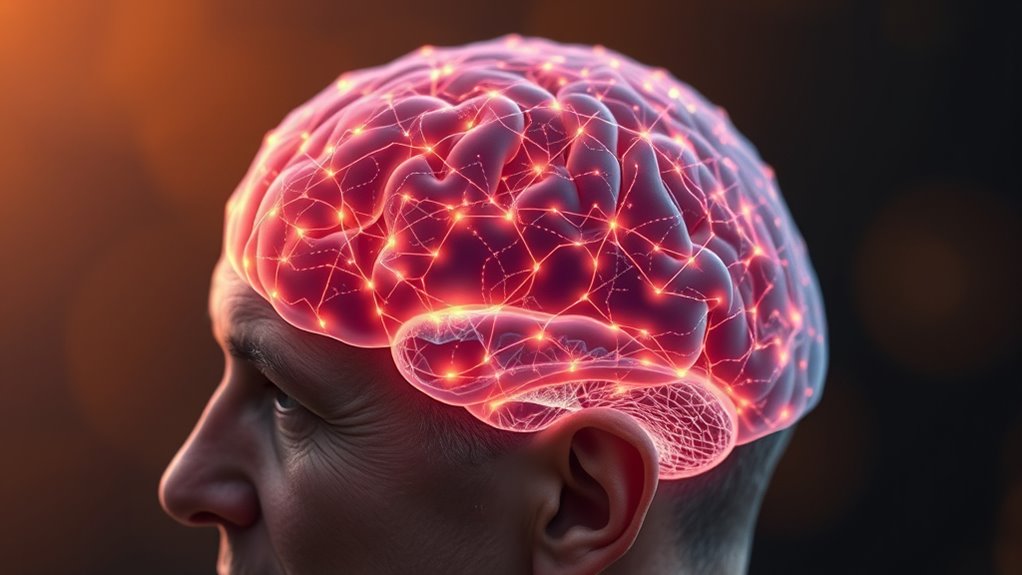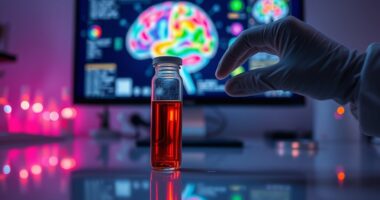Neuroplasticity stays active after 40, meaning your brain can still reorganize, strengthen connections, and adapt to new challenges. You can influence this process through mental exercises, physical activity, and a healthy lifestyle. Although some decline in neural growth occurs with age, ongoing stimulation helps maintain cognitive flexibility, memory, and learning. By embracing strategies that support brain health, you’re enhancing your ability to stay sharp and resilient as you age—if you want to learn more, keep exploring.
Key Takeaways
- Neuroplasticity remains possible after 40, allowing ongoing brain reorganization through mental stimulation and lifestyle factors.
- Peak neural efficiency occurs in the 30s and 40s, with gradual decline impacting memory, learning, and problem-solving.
- External factors such as exercise, diet, sleep, and stress management significantly influence neuroplasticity in midlife.
- Hormonal changes during menopause and aging can reduce neuroplasticity, but interventions like hormone therapy may help.
- Engaging in new learning, physical activity, and environmental enrichment supports brain health and adaptability after 40.
How the Brain Rewires After Age 40
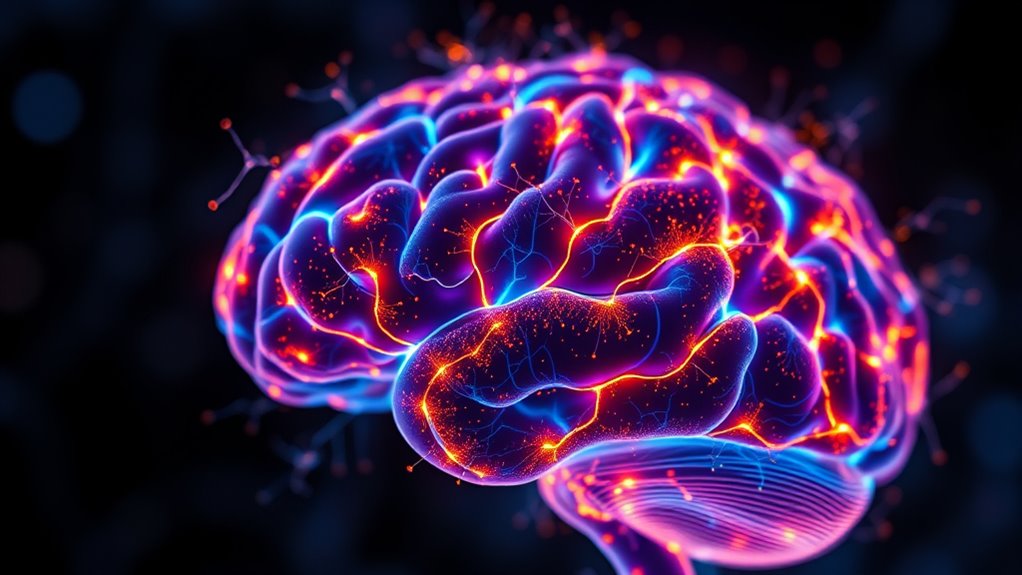
After age 40, your brain undergoes significant rewiring that changes how different regions connect and communicate. Early in life, your brain has many specialized networks with high internal connectivity. After 40, these networks become more integrated and globally connected, allowing different areas to work together more efficiently. This process involves a peak in neural efficiency during your 30s and 40s, which gradually declines with age. The rewiring affects cognition, influencing memory, learning, and problem-solving abilities. Your brain may also employ compensatory mechanisms, recruiting other regions to maintain performance despite aging-related changes. Over time, your brain becomes less regionally specialized and more broadly connected, reflecting ongoing reorganization that supports adaptation and resilience in later years. This dynamic adjustment highlights the brain’s capacity for neuroplasticity, even later in life. Additionally, research indicates that engaging in mentally stimulating activities can promote further brain rewiring, supporting cognitive health as you age. Consistent mental engagement and cognitive exercises are essential for maintaining and enhancing this adaptability. These changes demonstrate the remarkable ability of the brain to adapt through neural reorganization, underscoring the importance of continuous mental engagement.
The Role of Neurogenesis in Cognitive Resilience

As you age, your brain still has the ability to grow new neurons through neurogenesis, which supports memory and learning. This process helps build cognitive resilience, making it easier to adapt to stress and challenges. Additionally, studies suggest a correlation between neurogenesis and improved emotional regulation, further supporting mental health. However, age-related declines in neurogenesis can reduce these benefits, highlighting the importance of strategies to maintain brain plasticity. Utilizing appropriate headphone types can also enhance mental focus and relaxation, further supporting cognitive health as you age. Engaging in activities that promote active listening can stimulate neurogenesis and reinforce neural pathways, contributing to sustained mental agility. Moreover, maintaining good nutrition is essential, as certain nutrients can influence neurogenesis and overall brain health. Additionally, lifestyle factors such as regular exercise and a balanced diet can positively influence brain plasticity and neurogenesis, helping preserve cognitive functions over time.
Brain’s New Neuron Growth
Neurogenesis, the process of generating new neurons in the brain, continues into adulthood and even aging, playing a crucial role in maintaining cognitive resilience. Although it declines markedly with age—by about 70-80% in the hippocampus—some neurogenic activity persists, supporting brain plasticity and cognitive functions. Aging reduces neural stem cell responsiveness, limits progenitor cell pools, and makes the neurogenic environment less supportive. However, lifestyle factors like physical exercise and environmental enrichment can partly reverse these declines by boosting neuron proliferation and survival. This ongoing neurogenesis helps preserve learning, memory, and cognitive flexibility, making it a key factor in resilience against age-related decline. Even in old age, maintaining neurogenesis contributes to brain health and recovery from injury. Research indicates that engaging in music therapy and sound healing practices can further stimulate neural growth and enhance neuroplasticity, especially in aging brains. Additionally, neuroplasticity can be promoted through mental stimulation and social engagement, further supporting brain resilience. Enhancing the brain’s neurogenic capacity may also involve targeted interventions, which are currently being explored in clinical research to combat neurodegenerative conditions.
Memory and Learning Boost
The ongoing process of generating new neurons in the hippocampus considerably enhances your brain’s ability to learn and remember. Neurogenesis helps integrate new neurons into existing circuits, boosting learning capacity and memory formation. This process allows your brain to adapt by modifying neural pathways, which improves cognitive flexibility. Even as stress or aging challenge your mental functions, increased neurogenesis can counteract cognitive decline and prevent stress-related symptoms like impaired learning. The hippocampus’s role in memory is directly supported by neurogenesis, strengthening neural circuitry and supporting new learning experiences. This continuous neuron growth helps maintain cognitive resilience, ensuring your brain remains adaptable and responsive to new information, challenges, and environments well into later years. Additionally, adult neurogenesis is influenced by lifestyle factors such as physical activity and mental stimulation, which can further support cognitive health. Engaging in regular mental activities can stimulate neurogenesis and promote overall brain vitality.
Age-Related Neurogenesis Decline
With age, your brain’s ability to generate new neurons in key regions like the hippocampus declines, which can impair your cognitive flexibility. This decrease in neurogenesis results from a loss of neural stem cell activity and changes in gene expression, reducing the brain’s capacity to adapt and learn. As neurogenesis diminishes, you may experience more cognitive deficits and a higher risk of dementia. The decline impacts neuroprotective effects, making your brain more vulnerable to neurodegenerative diseases involving proteins like tau and Aβ. However, interventions such as exercise, lifestyle changes, and targeting pathways like mTOR and sirtuins hold promise for boosting neurogenesis. Hackathons can serve as innovative platforms to develop and test novel strategies for enhancing neuroplasticity. Restoring these processes could improve cognitive resilience and help maintain brain health as you age, especially when supported by neurogenesis research that is rapidly advancing in the neuroscience community. Additionally, understanding brain plasticity mechanisms can guide the development of effective therapies to counteract age-related decline. Incorporating nourishing activities such as healthy diets and mental exercises has also shown potential in supporting neurogenesis and overall brain health. Recent studies emphasize the importance of stem cell therapies as a future avenue for restoring neurogenesis and cognitive function.
Factors That Influence Neuroplasticity During Middle Age
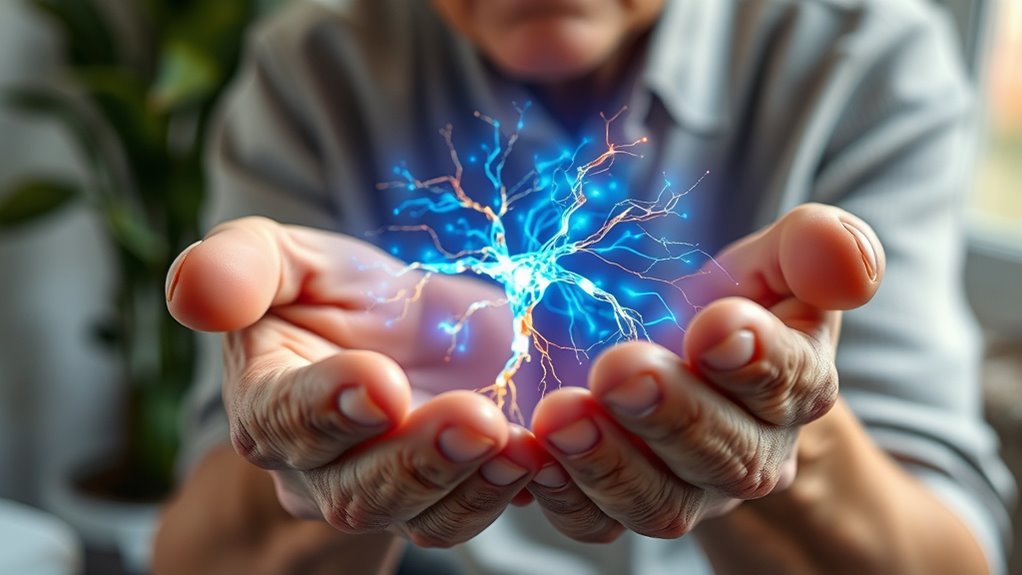
Hormonal changes during middle age can influence your brain’s ability to adapt and reorganize. Environmental stimuli like physical activity, social engagement, and cognitive challenges also play a vital role in supporting neuroplasticity. Additionally, emerging machine learning algorithms are being explored for their potential to better understand and enhance brain plasticity through personalized interventions. Researchers are also investigating how brain-derived neurotrophic factor levels fluctuate with age and impact neuroplasticity. To optimize these processes, understanding the influence of wax types and other materials can inform strategies for maintaining brain health as you age. Moreover, incorporating mindfulness practices such as meditation may further promote neuroplasticity by reducing stress and fostering mental resilience. Furthermore, engaging in personalized interventions tailored to individual neural profiles can maximize neuroplastic benefits and support cognitive vitality in middle age.
Hormonal Changes Impact
As you reach middle age, hormonal changes substantially influence neuroplasticity, shaping your brain’s ability to adapt and reorganize. The decline in ovarian estradiol during menopause reduces activation of estrogen receptors in memory-related regions like the hippocampus and prefrontal cortex. This decrease affects synaptic density and activity, impairing learning and memory. Hormone replacement studies suggest that restoring estrogen can partially reverse these effects, improving plasticity and cognitive function. Similarly, declining progesterone levels impact neurogenesis and neural excitability, influencing mood and cognition. Testosterone also plays a role, with its decrease in middle age linked to reduced synaptic plasticity and cognitive flexibility. These hormonal shifts, especially their timing, determine how well your brain adapts and maintains resilience during midlife. Additionally, fluctuations in water-based therapies and aquatic exercises may help support brain health by promoting circulation and reducing stress during this transitional phase.
Environmental Stimuli Role
Environmental stimuli play a significant role in shaping your brain’s ability to adapt during middle age. When you engage in enriched environments, your spatial memory and neural circuits, especially in the hippocampus, stay sharper longer. These experiences increase dendritic spine density and promote neurogenesis, which helps maintain a youthful brain. Higher education and active lifestyles boost brain reserve, delaying cognitive decline. Molecularly, enrichment elevates BDNF levels and activates signaling proteins like phospho-Akt and phospho-MAPK1/2, supporting plasticity. Positive stimuli strengthen neural connections and foster cell survival, while negative factors like stress can hamper neuroplasticity. Overall, maintaining stimulating environments enhances your brain’s resilience, preserving mental agility and protecting against age-related decline.
Changes in Sensorimotor Skills in Your 40s and Beyond

In your 40s and beyond, your sensorimotor skills begin to change as a natural part of aging. You may notice slower reaction times and decreased coordination, affecting daily tasks like driving or typing. Balance and mobility often decline, making postural control more challenging. Tactile sensitivity decreases, which can hinder fine motor skills such as buttoning shirts or handling small objects. Aging also impacts your brain’s ability to coordinate sensory input with motor responses, leading to delays in movement. Learning new motor skills becomes more difficult, and adapting to new sensorimotor challenges may require more effort. While these changes are normal, engaging in regular practice and staying active can help maintain your existing skills and support your overall sensorimotor health.
Strategies to Support Healthy Brain Aging
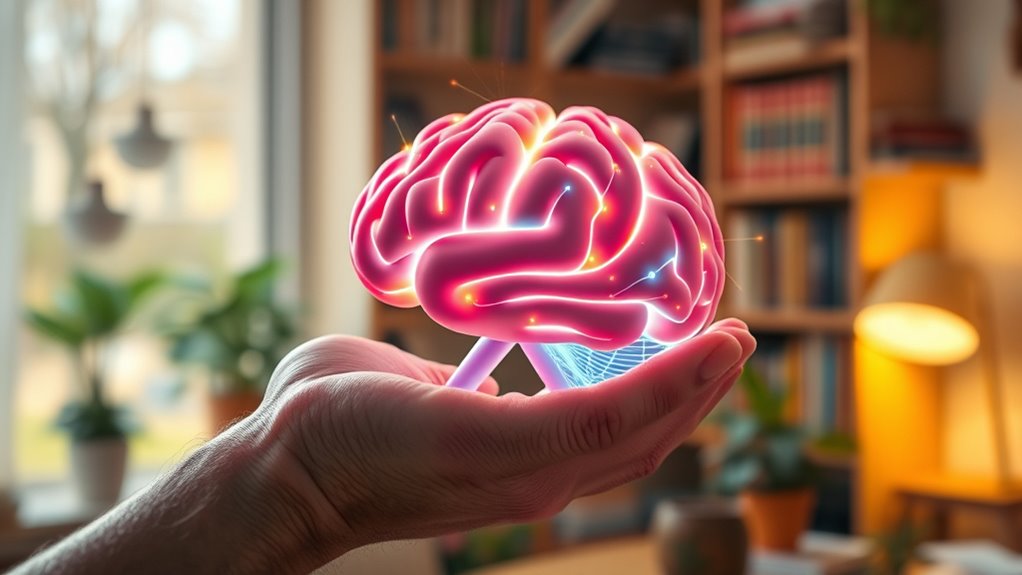
Supporting healthy brain aging involves adopting a combination of lifestyle changes that promote cognitive resilience. Regular physical exercise boosts blood flow and oxygen to your brain, enhancing neuroplasticity. Eating a balanced diet rich in fruits, vegetables, whole grains, and lean proteins helps fight inflammation and supports brain health. Staying well-hydrated is essential for ideal cognitive function. Limiting alcohol intake reduces risks of cognitive decline, while managing stress through activities like yoga or meditation helps protect your brain. Incorporating antioxidant-rich foods and omega-3 fatty acids, especially via a Mediterranean diet, further supports mental sharpness. Regular health screenings, quitting smoking, and managing chronic conditions also play key roles. These strategies combine to create a strong foundation for maintaining your cognitive vitality as you age.
Enhancing Neuroplasticity Through Mental Stimulation

Enhancing neuroplasticity through mental stimulation is a powerful way to keep your brain adaptable and resilient as you age. By engaging in activities that challenge your mind, you trigger changes like increased cortical representation and strengthened neural connections. Cognitive exercises, learning a new language, or tackling puzzles stimulate brain regions such as the hippocampus and prefrontal cortex. Mental rehearsal of motor skills can also boost neural plasticity, improving motor control. Regular mental stimulation promotes synaptic plasticity, neuronal growth, and network reorganization, helping maintain cognitive sharpness. Incorporating these activities into your routine supports ongoing brain adaptation, making it easier to learn new skills, process information, and recover from cognitive setbacks. Staying mentally active is a key strategy for lasting brain health after 40.
Neuroplasticity and Recovery From Brain Injuries
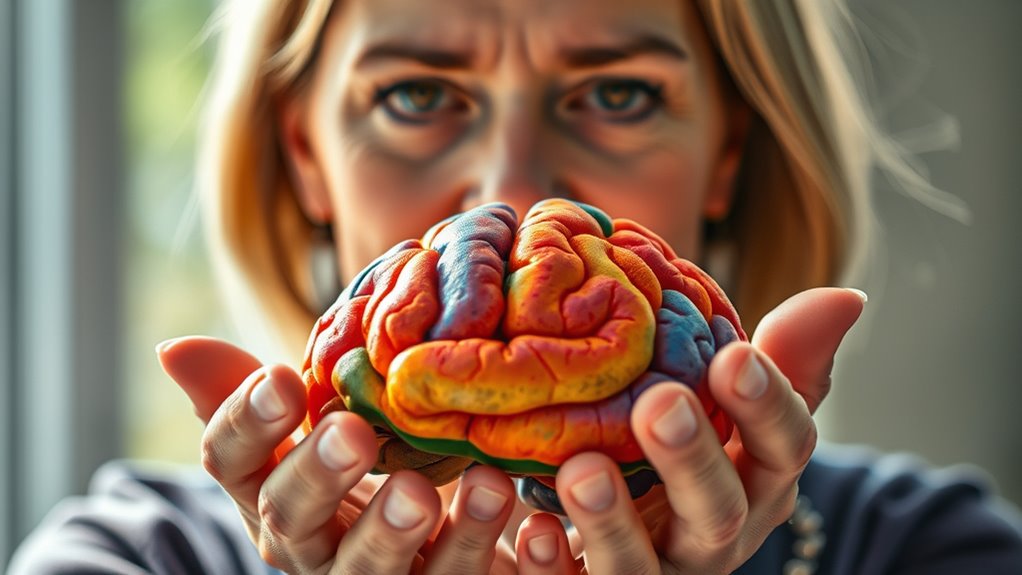
Neuroplasticity plays a vital role in your brain’s ability to recover from injury by reorganizing neural pathways and forming new connections. This process allows you to regain lost motor, sensory, and cognitive functions. Cellular mechanisms like synaptic plasticity, axonal sprouting, and dendritic remodeling enable your brain to adapt after damage. Recovery involves both immediate and delayed neuroplastic changes, with some improvements occurring soon after injury and others developing over time. The severity and type of brain injury influence how your brain reorganizes itself. Targeted therapies, such as physical and cognitive rehabilitation, harness neuroplasticity to promote recovery. Emerging techniques like transcranial stimulation further enhance this process, helping you maximize functional gains and adapt to new neural pathways.
Building Cognitive Resilience in Later Years

As you age, building cognitive resilience becomes essential for maintaining mental sharpness and independence. Your brain’s ability to adapt relies on genetic, molecular, and lifestyle factors. Engaging in intellectually stimulating activities helps strengthen your cognitive reserve, allowing you to better cope with age-related changes. Regular exercise, a diet rich in antioxidants and omega-3s, and social interactions support brain health and resilience. Your psychological wellbeing also plays a vital role; managing stress, maintaining positive emotions, and seeking emotional support boost your affective reserve. Understanding these factors enables you to adopt targeted strategies, such as lifelong learning and mental health care, to enhance your brain’s capacity to withstand aging effects. Building resilience today can delay cognitive decline and preserve your independence tomorrow.
The Future of Neuroplasticity-Based Therapies
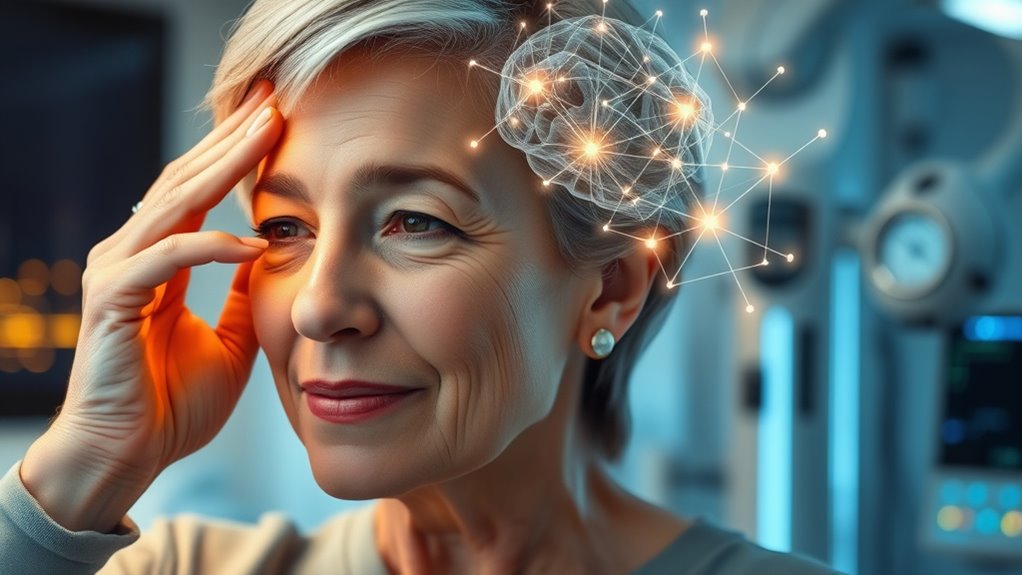
The future of neuroplasticity-based therapies looks promising as technological advancements and research efforts continue to accelerate. You’ll benefit from refined non-invasive brain stimulation techniques like TMS, tDCS, and tES, which are becoming more precise in targeting specific brain regions. Researchers are working to optimize stimulation parameters, making treatments more effective for conditions such as Parkinson’s-related fatigue. The BRAIN Initiative aims to map brain circuits and develop personalized therapies based on neuroplasticity mechanisms. Emerging technologies like brain-computer interfaces and advanced neurostimulation tools will likely revolutionize rehabilitation and cognitive enhancement. As science deepens its understanding of molecular and cellular processes, future therapies will become more tailored, helping you harness your brain’s incredible capacity to adapt well into later years.
Frequently Asked Questions
Can Neuroplasticity Reverse Age-Related Cognitive Decline?
You might wonder if neuroplasticity can reverse age-related cognitive decline. The good news is, it can! Your brain stays adaptable even in older age, responding to activities like exercise, mental stimulation, and healthy habits. These interventions can boost memory, attention, and executive functions, sometimes reversing or slowing decline. By staying active and engaged, you harness your brain’s plasticity to maintain and improve cognitive health well beyond 40.
How Do Lifestyle Choices Impact Neuroplasticity After 40?
You might think your brain’s done changing after 40, but that’s not true! Your lifestyle choices can turn your brain into a powerhouse of neuroplasticity. Exercise, eat a brain-boosting diet, stay socially active, and get good sleep. These habits flood your brain with growth factors, strengthen connections, and even spark new neurons. So, yes, what you do today can transform your brain into a resilient, adaptable marvel well beyond 40!
Is Neuroplasticity the Same in All Individuals Over 40?
You might wonder if neuroplasticity is the same in everyone over 40. It’s not—neuroplasticity varies widely among individuals due to genetics, lifestyle, and environment. Some people actively engage in learning and physical activity, which boosts their brain’s adaptability, while others may see less benefit. Your unique genetics and experiences shape how your brain rewires and responds, making neuroplasticity a highly personal process after 40.
What Role Do Genetics Play in Neuroplasticity During Aging?
They say “you are what you make of yourself,” and genetics play a big part in that. Your genes influence how your brain reorganizes and adapts as you age. Certain genes impact cognitive functions and resilience, affecting neuroplasticity. While lifestyle matters, your genetic makeup sets the foundation for how well your brain can change, learn, and recover, especially after 40. Understanding this helps tailor strategies to maintain mental agility.
Are There Specific Exercises to Enhance Neuroplasticity in Middle Age?
You can boost neuroplasticity in middle age by engaging in a variety of exercises. Aerobic activities like walking, running, or cycling improve brain function, while resistance training and mind-body practices like yoga or tai chi enhance neural adaptability. Combining physical activity with skill-based and cognitive challenges, such as learning new hobbies or solving puzzles, further stimulates brain growth. Personalizing these exercises to your preferences increases motivation and maximizes benefits.
Conclusion
Your brain’s ability to rewire itself after 40 is like a garden that still blooms with care and attention. By staying mentally active, nurturing healthy habits, and embracing new challenges, you can keep your mind vibrant and resilient. Remember, neuroplasticity is your lifelong partner in growth—proof that even as the years pass, your brain remains a remarkable work in progress, ready to adapt and flourish at any age.
